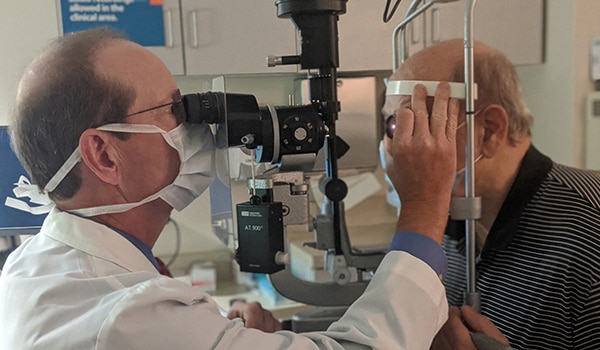New Study Finds Surgery and Drug Treatments Equally Effective for Diabetic Eye Disease

The findings will help guide treatment for people with bleeding in the eye from proliferative diabetic retinopathy.
A new clinical study, supported by the National Eye Institute (NEI), found that surgical and injectable drug approaches are equally effective for treating bleeding inside the eye from proliferative diabetic retinopathy (PDR).
A consequence of diabetes, PDR can lead to retinal tissue death, permanent vision loss, and eventually blindness in some patients. Before surgery and laser treatments were developed to remove the blood and regress abnormal blood vessel growth, PDR was a leading cause of blindness in the United States.
In this study, the DRCR Retina Network (DRCR.net) team compared two standard treatments—anti-vascular endothelial growth factor (VEGF) eye injections versus the removal of blood via vitrectomy surgery and laser photocoagulation. The purpose of this comparison was to see if either treatment was more effective in improving visual acuity over two years. Of 205 participants, 100 were assigned an anti-VEGF drug, aflibercept (brand name Eylea), and 105 were assigned prompt vitrectomy and laser photocoagulation. The researchers tracked best-corrected visual acuity over two years. At four weeks, visual acuity in the surgery group was significantly higher than the anti-VEGF group, but by 24 weeks, the visual acuity in the anti-VEGF group had caught up to the surgery group.
The results of the study showed that visual acuity was similar between the two groups out to two years. Approximately one in three participants in each group eventually received both types of treatments to help control their PDR during that time. These findings will help guide treatment for people with bleeding in the eye from PDR.
“This clinical trial was an opportunity to compare two commonly used treatments for vitreous hemorrhage from proliferative diabetic retinopathy head-to-head. The results provide useful guidance for clinicians who are managing patients with this condition,” said Adam Glassman, Jaeb Center for Health Research, director of the DRCR.net coordinating center.
“About a third of our study participants ended up needing both treatments,” said Glassman, “so we think it’s critical that people continue to follow up with their clinicians after starting treatment for PDR, because they may need to adjust their treatment along the way to get the best outcome.”
The results of this study were published in the Journal of the American Medical Association. For more information, view the full NIH press release.
